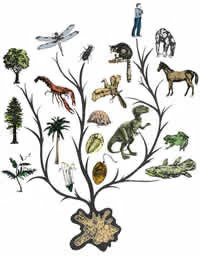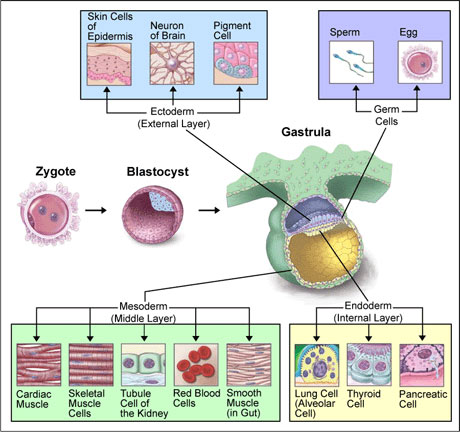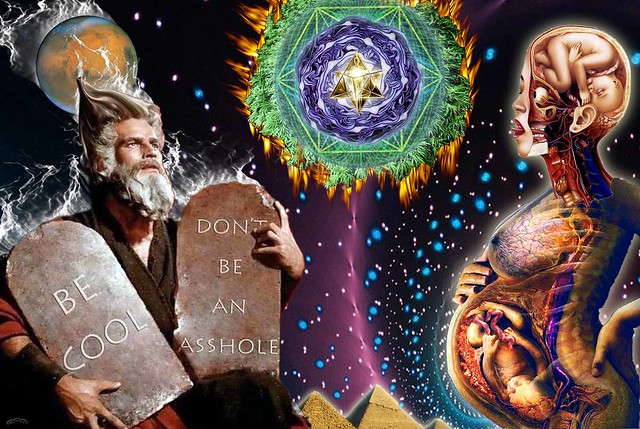Programmed Evolution:
Ontogeny, Phylogeny, Teleology and Evolution’s Empirical Conundrum
by  Star Larvae
Star Larvae
 Star Larvae
Star Larvae Scientists and philosophers of science have proposed various metrics by which to assess the merits of scientific theories. An often cited one is Karl Popper’s requirement that a theory be in principle empirically falsifiable. For example, the discovery of rabbit fossils in Precambrian geological strata would demolish Darwinian theory. Another often cited measure of merit is a theory’s ability to make accurate predictions. This has always been a difficult hurdle for Darwinian evolution. What predictions can the theory make?
Unfortunately for Darwinian theory, the difficulties are several. They include the time scale required, the need to rely on necessarily incomplete fossil remains, and the small sample (one planet). But something new has changed the situation. Darwinian theory now is in a position to belly up to the bar and, like other respectable scientific theories, make some bold predictions.
What has changed is our ability to analyze DNA. Genomic sequencing and analysis projects are in full swing around the world. Researchers are using new technologies to, not only sequence DNA, but also statistically analyze those sequences across species. So, Darwinians, what’s going to come of it? If you understand how changes in DNA propagate through generations within a species and into new species, if you understand the sources of genetic novelty, if you understand why some genes are preserved in a species and others selected out, then let’s have some predictions.
What will ongoing genetic sequencing and analysis turn up that will corroborate Darwinian evolution and falsify rivals?
But before we try to pin Darwinists to the mat, let’s entertain a relevant thought experiment, as an intermission:
Let’s suppose that we observe a complex process, one that involves discernibly discrete entities. We might call these entities organisms. We notice that over time, as the process progresses, the organisms give rise to new organisms. And we notice that older organisms perish.
We notice that the descendants differ from their ancestors. As more generations turnover, the forms of the descendants vary more dramatically. Morphological forms, and their attendant functions and behaviors, proliferate through the population of descendant organisms. And, having been fortunate enough to observe the process from its outset, we know that the multiplicity of forms descended, ultimately, from a single ancestral form.
An intriguing process. How to account for it? Let’s consider two competing theories.
(1) We might conjure an explanation that invokes a more or less deterministic influence, one that bridges the generations and guides the process as it works its way from the ancestral form to the many descendant forms. Such an influence would be teleological. We might call this formative influence a genetic program. Its action across the generations would constitute development, an unfolding of pre-programmed potential into a multiplicity of forms.
(2) Alternatively, we might conjure an explanation that invokes nondeterministic, nonteleological factors. We might say that the process is the result of two interacting subprocesses, one being unpredictable changes that exaggerate variation among the members of a generation, and the second being the varying numbers of progeny that members of each generation leave behind. We might call the first subprocess random mutation and the second process natural selection, and we might posit a relationship between the two that causes descendant populations to display a diversity of morphologies (and functions and behaviors) based on pure chance and environmental selection. There is no preprogrammed potential unfolding, just selection among various traits among individuals and a disproportionate retention in descendant generations of the selected traits.
Now comes the hard part: determining which explanation best accounts for the observed process of descent. Being conscientious scientists, we want empirical corroboration. What observations might we make, in principle, that could determine which explanation has the greater merit? How would one distinguish, empirically, a teleological process from a Darwinian one? What would one look for to detect the presence or absence of a program?

Phylogeny: Polymorphous descent from a common ancestor. In principle, what sort of observation would establish the presence or absence of a program?
 Ontogeny: Polymorphous descent from a c
Ontogeny: Polymorphous descent from a common ancestor. In principle, what sort of observation would establish the presence or absence of a program?
One observation that would help clear the air is the discovery of an information code in the organisms that expresses itself as the organisms’ various morphological traits. The codes for the traits we might call genes. If we were to find genes in ancestors that lay waiting, unexpressed, but are preserved and jump to life in descendant species, this would bolster the case for a programmatic process.
A Darwinian process would not predict such a discovery. Darwinism includes no anticipatory mechanism whereby genes needed in the future would be present, though dormant, in ancestors. Only a teleological theory would predict an anticipatory genome. Anticipatory evidence would suggest a pre-coded program underlying the process of multi-generational morphological diversification.
And this is precisely what we observe in ontogeny. We observe that genes dormant in the fertilized ovum do not express themselves until the time comes for them to produce muscle cells, liver cells, brain cells, etc. Then these dormant genes spring to life. Their expression unfolds sequentially to create descendant species of cells of multifarious types.
Or at least this is the prevailing account. Alternatively, maybe it’s just a coincidence that genes dormant in the fertilized ovum are useful in descendant cell types. Maybe nature is resourceful and discovers uses for the inherited supply of genes. It might be the case that the differentiation of cell types during embryonic development has nothing to do with any precoded program. Maybe it’s happenstance, the result of random mutations and natural selection.
This line of thinking probably is not worth pursuing. But is phylogenetic descent really that different? Would the discovery of descendant genes in ancestors argue for a programmed phylogeny, or would it argue only for the happenstance of random mutations and natural selection?
These are no longer rhetorical questions, because genomic sequencing and analysis is finding unexpected, unpredicted instances of descendant genes in ancestors. Does Darwinian evolution predict that the genomes of primitive species should contain genetic programs for newer, more complex species—?The discovery challenges the logic of normal evolution theory, because it suggests that evolution, as ontogeny is thought to do, unfolds from a pre-programmed genetic potential. These findings are ongoing:
A news release (11/24/2005) issued by the journal Trends in Genetics announces that
"Corals and sea anemones (the flowers of the sea), long regarded as merely simple sea-dwelling animals, turn out to be more genetically complex than first realised. They have just as many genes as most mammals, including humans, and many of the genes that were thought to have been "invented" in vertebrates are actually very old and are present in these "simple" animals."
The full text of the release is available at http://www.sars.no/research/technau_Science.pdf
Newer (2007) sequencing and analysis results corroborate the anemone anomalies. Another example comes from research at the European Molecular Biology Laboratory, which found human genes in a marine worm. The news release (11/24/2005) announcing the finding is at http://www.embl-heidelberg.de/aboutus/news/press/press05/press25nov05/index.html
Additional research discovered that genes essential for human nerve cells to communicate with one another are present already in bacteria. This research is described in a NIH news release (6/1/2004) at http://www.nichd.nih.gov/new/releases/genes.cfm These and other anomalous (in the Darwinian context) results of genome analysis are collected at http://www.panspermia.org/oldgenes.htm.
This page of Brig Klyce’s "Cosmic Ancestry" web site includes commentary on the relevance of these findings to panspermia. The discovery of advanced genes in primitive organisms suggests that the evolution of life on Earth constitutes an ontogeny—the ontogeny of Gaia.
If a process of descent is programmatic, then it would seem to be dependent on some kind of timing mechanism. What triggers the production of new descendant types? How does the developing embryo know when to kick out a new cell/tissue type? In the case of ontogeny, researchers posit various chemical signals from within the organism and/or from its gestating parent as potential triggers. In the case of phylogeny the timing triggers are harder to determine.
Nonetheless, various candidates present themselves. Phylogeny might also be paced by chemical signals. Organisms exchange chemical signals all the time, through eating one another, through exchanges of pheromones. Terence McKenna argues that ingestion of plant drugs among our primate ancestors played a role in human speciation. Other environmental triggers might include the terraforming of Earth’s atmosphere by the release of oxygen from photosynthesis. Glaciations might act as triggers. Industrial pollution is another candidate.
Maybe the prevailing accounts of ontogeny and phylogeny are artifacts of the time scales involved. If we could observe a sped-up movie of evolution might we perceive a programmatic development from the first to the most recent species—the gestation of a pregnant planet from impregation to delivery? If the embryonic development of a long-lived organism required a few billion years, might it not look like a Darwinian process?
So how do approaches to evolution stack up as scientific theories based on their abilities to predict? A teleological, programmed model, predicts that genes active in descendant species can be found already in distant ancestors. What does the Darwinian model predict? Genomic sequencing and analysis is in the early stages. There’s time to render predictions. The star larvae hypothesis predicts an accumulating pile of anomalous data that will stretch the Darwinian model to the breaking point. Those data, however, will find themselves well integrated in a new paradigm, one that proposes an overarching ontogeny that envelops evolution and repositions biology into the role of larvae to the stars.
From Star Larvae @ http://starlarvae.blogspot.com.au/2008/12/ontogeny-phylogeny-teleology-and.html

For more information about new evolutionary paradigms see http://nexusilluminati.blogspot.com/search/label/evolution
- Scroll down through ‘Older Posts’ at the end of each section
Thanks to: http://nexusilluminati.blogspot.com






 Sat Mar 23, 2024 11:33 pm by globalturbo
Sat Mar 23, 2024 11:33 pm by globalturbo


